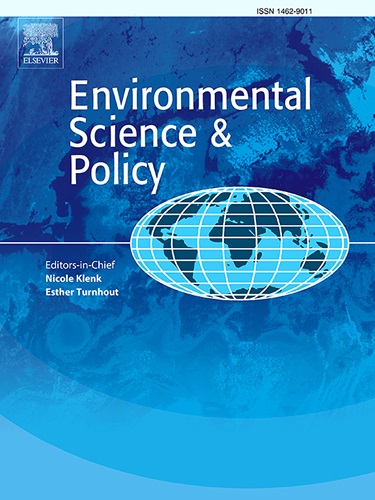Measuring soil, making territory: Developing eDNA and other soil biodiversity indicators in Finland as a struggle over scales of governance
IF 5.2
2区 环境科学与生态学
Q1 ENVIRONMENTAL SCIENCES
引用次数: 0
Abstract
As a key instrument of governance, indicators are world-making; and yet, the processes by which indicators are made are rarely critically examined or opened to public scrutiny. Monitoring a soil biodiversity, as part of monitoring soil health, is increasingly relevant to policy. Healthy soils are cast as a ‘nature-based solution’ to socio-ecological challenges such as sustainable food production, land degradation, human health, and climate change. In this paper, we shed light on the unexamined politics of soil biodiversity indicators, with Finland as a case study. Our discourse analysis of 103 governance and grey literature documents finds that tensions around indicators can clearly be seen as struggles over the scale of governance. Soil biodiversity indicators are part of the EU’s project of territorialization: an attempt to create governable territories for EU-scale ecosystem services optimization. We find that in Finland eDNA emerges as the preferred scientific basis for soil biodiversity governance due to an alignment of interests between scientific and policy groups concerned with cost efficiency and competitive prestige. However, critical voices, especially from within land workers’ organisations, argue that basing soil policies on eDNA methods risks obscuring local specificity, and creating environmental and social injustice. Instead, alternative indicators are called for and proposed, which are more relevant at local scales of action: accessible, and epistemically just. Without heeding these critical voices, we argue, soil biodiversity science and governance risks further alienating land management groups - who are indispentible in achieving soil health. We call, therefore, for soil biodiversity indicators and knowledge infrastructures centered on strengthening the capacities of the very people tasked with delivering soil biodiversity improvements: land workers.
测量土壤,创造领土:在芬兰开发eDNA和其他土壤生物多样性指标,作为治理规模的斗争
作为一项关键的治理工具,指标具有重大意义;然而,制定指标的过程很少受到严格审查或公开接受公众监督。监测土壤生物多样性,作为监测土壤健康的一部分,与政策的关系日益密切。健康土壤被视为应对可持续粮食生产、土地退化、人类健康和气候变化等社会生态挑战的“基于自然的解决方案”。在本文中,我们以芬兰为例,阐明了土壤生物多样性指标的未经审查的政治。我们对103份治理和灰色文献的话语分析发现,围绕指标的紧张关系可以清楚地视为治理规模的斗争。土壤生物多样性指标是欧盟属地化项目的一部分:试图为欧盟规模的生态系统服务优化创造可治理的领土。我们发现,在芬兰,由于关注成本效率和竞争声望的科学和政策团体之间的利益一致,eDNA成为土壤生物多样性治理的首选科学基础。然而,批评的声音,特别是来自土地工人组织内部的声音认为,将土壤政策建立在eDNA方法的基础上可能会模糊当地的特殊性,并造成环境和社会的不公正。相反,我们呼吁并提出了其他指标,这些指标在地方行动规模上更为相关:可获得的、认识上公正的。我们认为,如果不听取这些批评的声音,土壤生物多样性科学和治理就有可能进一步疏远土地管理团体——他们在实现土壤健康方面是不可或缺的。因此,我们呼吁建立土壤生物多样性指标和知识基础设施,重点是加强负责改善土壤生物多样性的人的能力:土地工人。
本文章由计算机程序翻译,如有差异,请以英文原文为准。
求助全文
约1分钟内获得全文
求助全文
来源期刊

Environmental Science & Policy
环境科学-环境科学
CiteScore
10.90
自引率
8.30%
发文量
332
审稿时长
68 days
期刊介绍:
Environmental Science & Policy promotes communication among government, business and industry, academia, and non-governmental organisations who are instrumental in the solution of environmental problems. It also seeks to advance interdisciplinary research of policy relevance on environmental issues such as climate change, biodiversity, environmental pollution and wastes, renewable and non-renewable natural resources, sustainability, and the interactions among these issues. The journal emphasises the linkages between these environmental issues and social and economic issues such as production, transport, consumption, growth, demographic changes, well-being, and health. However, the subject coverage will not be restricted to these issues and the introduction of new dimensions will be encouraged.
 求助内容:
求助内容: 应助结果提醒方式:
应助结果提醒方式:


